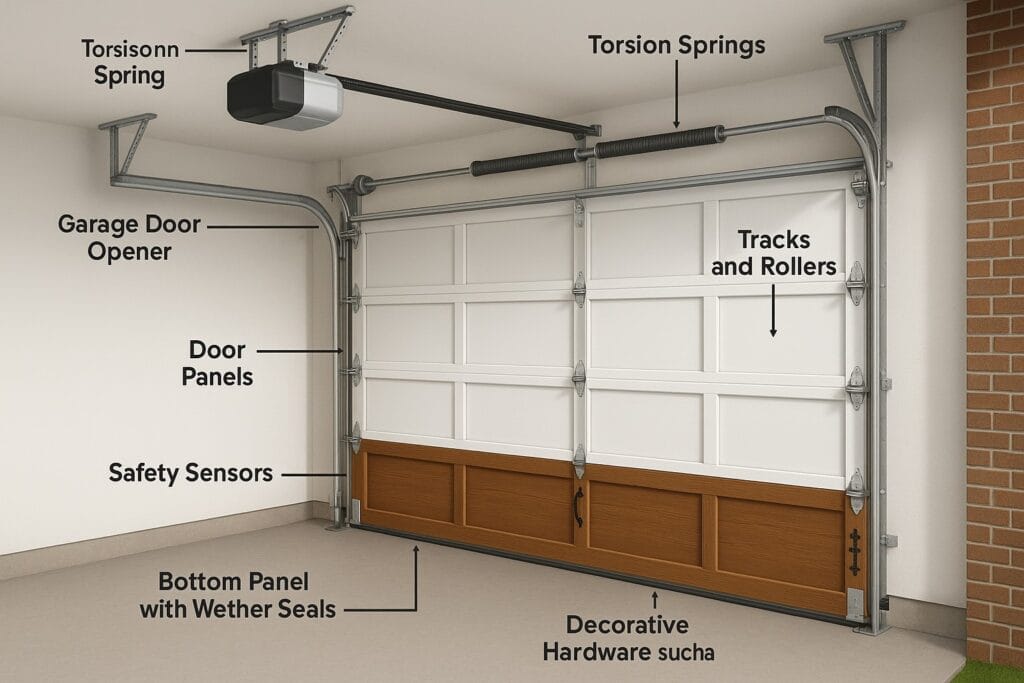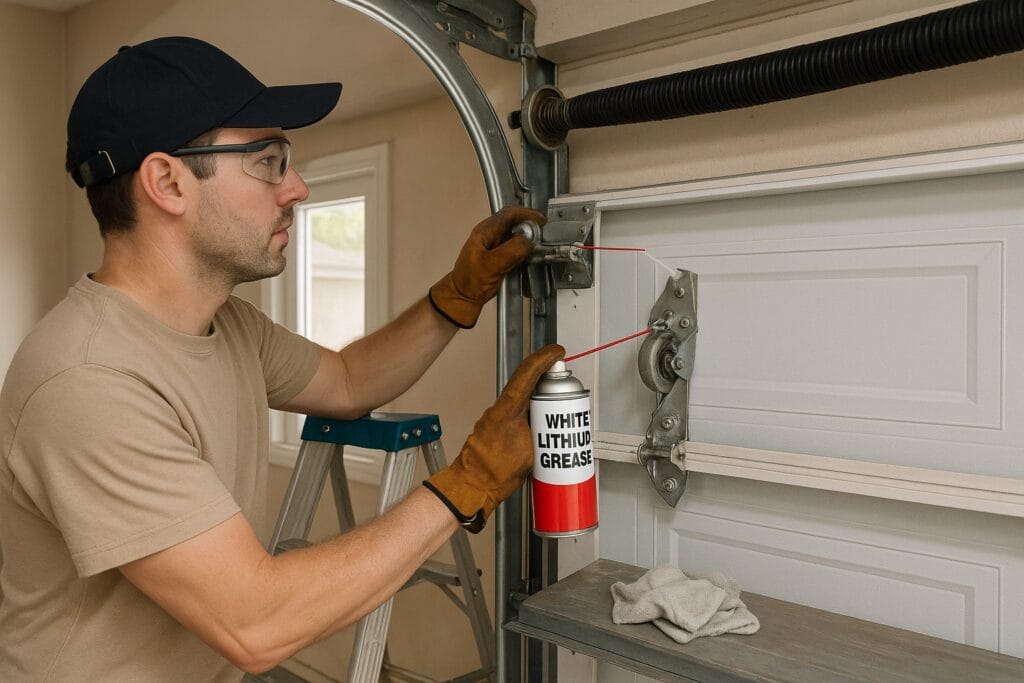What First-Time Homeowners Should Know About New Garage Door Installation

Imagine you’ve just moved into your first home in Austin, TX. The lawn is freshly mowed, the walls are newly painted, and you finally have your driveway. But there’s one thing that doesn’t feel quite right: the old, creaky garage door. That was exactly the case for one of our recent clients. Within a week of moving in, they called us because their garage door refused to open one morning. Upon inspection, we discovered it had broken torsion springs, severely worn tracks, and a garage door opener that was completely non-functional. We replaced it with a high-performance, insulated steel garage door complete with a smart garage door opener and decorative hardware. Now, not only does the door operate with smooth precision, but it has also dramatically improved their home’s curb appeal and energy efficiency.
According to real estate experts, upgrading or installing a new garage door can recoup up to 102.7% of its cost in added property value. That makes garage door installation one of the smartest investments a first-time homeowner can make. But navigating the process of selecting, purchasing, and installing a new garage door can be overwhelming, especially if you don’t know what to look for in materials, hardware, style, safety features, or installation teams.
Whether you’re upgrading an old garage door or outfitting a newly constructed garage, understanding the steps involved in a professional new garage door installation can help you avoid mistakes, reduce long-term maintenance costs, and ensure optimal performance. This comprehensive guide by Waller Creek Garage Doors covers everything you need to know to make an informed decision.
Understanding the Basics of New Garage Door Installation
A garage door is more than just an entry point to your home; it’s a complex mechanical system made up of numerous components that must work together seamlessly. Understanding these basics can empower you to make smarter decisions during the installation process.
Key Components:
- Garage Door Panels: These form the outer face of your garage door. Whether you choose steel, aluminum, wood, or fiberglass, the panel style affects aesthetics, insulation, and durability.
- Tracks and Rollers: These guide your door as it opens and closes. High-quality tracks and nylon rollers reduce noise and increase the lifespan of the system.
- Springs: The torsion or extension spring system offsets the heavy weight of the door, enabling it to open and close with ease. Proper calibration is crucial for safety.
- Hinges, Brackets, and Hardware: These components hold the door together and allow it to bend and fold as it moves along the track. Rust-proof materials are a must.
- Garage Door Opener: Available in different types like screw drive, belt drive, and chain drive, the opener powers the system. Modern openers support remote access, keypads, and app-based controls.
- Safety Sensors: These sensors are mounted near the bottom of the door frame. They prevent the door from closing if something is detected in its path, essential for protecting children and pets.
- Door Frame and Bottom Panel: A properly squared and sealed door frame supports structural integrity, while a weatherproof bottom panel helps keep out moisture, pests, and drafts.

Each part must be selected and installed with precision to guarantee smooth operation, safe performance, and reduced energy consumption over time.
Choosing the Right Garage Door for Your Home
Choosing the right garage door isn’t just about finding something that fits. You’ll want to consider style, safety, energy efficiency, maintenance, and cost, all while ensuring it complements your home’s design.
1. Materials and Durability
- Steel Doors: Most common due to their strength, affordability, and variety of finishes. Great for security and available with insulation options.
- Aluminum: Light and corrosion-resistant, perfect for humid climates, though not as impact-resistant as steel.
- Wood: Adds a classic, rustic charm. Ideal for custom designs but requires more upkeep to avoid warping or insect damage.
- Composite/Fiberglass: Provide the look of wood without the heavy maintenance. Highly resistant to environmental wear and tear.
2. Insulation and Energy Efficiency
Insulated garage doors help regulate your home’s temperature and lower your energy bills. Double- or triple-layer doors filled with polyurethane or polystyrene foam are excellent choices. The R-value measures insulation effectiveness; the higher, the better.
3. Style, Design, and Curb Appeal
A garage door often makes up over 30% of your home’s front exterior. Options include:
- Raised panel designs
- Carriage house styles with decorative hardware
- Flush or full-view glass panels for a modern look
Colors and finishes can be coordinated with your shutters, trim, or front door for a cohesive aesthetic.
4. Smart Features and Additional Technology
Modern openers provide advanced features like:
- Remote access via smartphone apps
- Real-time security alerts
- Battery backup for power outages
- Automatic closing timers
Many systems now offer compatibility with smart home platforms such as Google Assistant, Amazon Alexa, and Apple HomeKit.
What to Expect During the Garage Door Installation Process
Understanding each step of the installation process prepares you to ask the right questions, anticipate timing, and ensure quality outcomes.
Step 1: Pre-Installation Assessment
Our expert installation team will evaluate the garage’s existing condition, confirm measurements, inspect the door frame, and assess electrical and mounting readiness for the new garage door opener. We’ll identify any pre-installation repairs that might be necessary.
Step 2: Old Door Removal
All components of the old garage door, panels, hinges, tracks, springs, and opener, are carefully dismantled and removed to avoid damaging the structure or interior walls of the garage.
Step 3: Hardware and Track Setup
New steel tracks are installed on each side of the opening. Reinforced brackets and support hardware are anchored into wall studs to ensure a stable framework. Rollers and side hinges are installed on each panel.
Step 4: Garage Door Opener Installation
Your chosen opener is mounted to the ceiling or wall. The drive carriage and motor rail are aligned and securely fastened. Wiring is connected for wall control, safety sensors, and remote access systems.
Step 5: Panel and Spring Installation
Door panels are stacked and joined with heavy-duty hinges. Torsion springs are mounted above the door and precisely wound to achieve correct tension, which is vital for safe, efficient operation.
Step 6: Final Adjustments and Testing
We run multiple test cycles to ensure the door opens and closes smoothly and safely. Adjustments are made to spring tension, opener settings, and sensor calibration to guarantee full functionality.
Safety Considerations for First-Time Homeowners
Your new garage door is only as safe as its installation and maintenance. Here are key safety factors to keep top of mind:
1. Professional Installation is Essential
DIY garage door installation is not recommended. Torsion springs and lifting components are under immense tension and can cause serious injury if mishandled. Trained installers adhere to safety codes and industry best practices.
2. Understand Emergency Features
All openers include a manual release mechanism. Know where it is and how it works. Practice using it during calm conditions so you’re prepared during emergencies or power failures.
3. Keep Sensors Unobstructed
Regularly check that safety sensors are aligned and free of dirt or blockages. Misaligned or malfunctioning sensors can disable the auto-reverse feature, creating a potential hazard.
4. Install Motion Detection Lighting
Enhance your garage’s safety and convenience with lighting systems that activate automatically when someone enters.
Common Mistakes First-Time Homeowners Make
Avoid these pitfalls to get the most out of your new garage door investment:
- Going for the Cheapest Option: A bargain door often lacks key features like proper insulation, rust-resistant hardware, and smart tech compatibility.
- Skipping Wind Rating Requirements: High wind events in Texas mean your door must meet local code specifications for wind load resistance.
- Overlooking Maintenance Plans: Scheduling annual inspections and servicing reduces the risk of costly failures.
- Failing to Match the Home’s Design: A mismatched garage door can detract from your property’s overall appeal and even violate HOA standards.
Local Codes, Climate, and Design Preferences in Austin, TX
Austin’s mix of heat, humidity, and occasional storms makes it important to install doors built for durability and energy savings.
- Wind Load Compliance: Ensure the door meets the International Residential Code (IRC) for wind pressure.
- Energy Efficiency: High R-value insulation, UV-resistant coatings, and thermal breaks help manage indoor temperatures.
- Aesthetic Guidelines: Always verify with your HOA or neighborhood association before selecting bold colors or modern finishes.
Cost Breakdown and Long-Term Value
Here’s what you might expect in terms of budgeting:
- Basic Steel Doors: $700 – $1,500
- High-End or Custom Doors: $2,000 – $5,000+
- Garage Door Opener: $150 – $600, depending on features
- Labor and Installation: $200 – $500
- Additional Features: Smart controls, windows, designer finishes, and extended warranties may increase cost
When viewed as a long-term investment, the value far exceeds the price. A professionally installed garage door boosts security, comfort, and property value while minimizing energy waste and maintenance needs.
Post-Installation Tips for Long-Term Performance
Protect your new garage door by following these expert-recommended maintenance practices. These routines help preserve smooth operation, improve energy efficiency, and extend the life of key components such as springs, rollers, and the garage door opener system. Incorporating these into your regular home care plan ensures optimal performance and prevents costly repairs over time.
1. Perform Monthly Safety Tests
Test the auto-reverse function using a piece of wood placed in the door’s path—if the door doesn’t reverse immediately, it’s a sign the safety mechanism needs adjustment. Also, check the manual release handle to confirm it disengages the opener smoothly, allowing you to lift the door manually in case of a power outage. Ensuring these safety features function properly can prevent injuries and protect property.
2. Schedule Biannual Professional Tune-Ups
Have your entire system inspected by a garage door professional every six months. They’ll fine-tune spring tension, tighten loose bolts or brackets, test door balance, and inspect the opener logic board and safety sensors. These preventative adjustments help minimize wear and tear on torsion springs and avoid unexpected breakdowns.
3. Lubricate Moving Parts
Apply a silicone- or lithium-based garage-door-specific lubricant to hinges, torsion springs, tracks, and rollers. Regular lubrication reduces friction, quiets noisy doors, and prevents rust and corrosion from developing on metal parts. Avoid using WD-40, which is a cleaner, not a lubricant; it can degrade protective coatings and attract dust.

4. Clean Door Surfaces and Check Weather Seals
Wash the door’s exterior panels with mild soap and water to remove grime, salt, and environmental buildup that can damage the finish over time. Don’t forget to inspect the bottom panel’s weather stripping; damaged or brittle seals allow drafts, moisture, and pests to enter, compromising insulation and energy efficiency. Replace any worn-out seals promptly to maintain a tight, protective barrier.
5. Keep the Tracks and Door Path Clear
Always ensure the tracks are free from obstructions such as dirt, pebbles, or misaligned brackets that could interfere with door movement. Likewise, avoid placing tools, bikes, ladders, or storage bins in the area where the door operates, as this can result in damage to both the items and the door. A clean, unobstructed path helps your garage door system operate safely and efficiently.
How Can Waller Creek Garage Doors Help You?
At Waller Creek Garage Doors, we provide more than just installation; we offer peace of mind. We specialize in helping first-time homeowners in Austin and surrounding communities find the perfect garage door solution that balances style, security, and efficiency.
From traditional roll-up garage doors to modern steel models with advanced insulation and smart features, our team handles every step of the process with expert care. We ensure the right garage door for your home, lifestyle, and budget while offering ongoing support through maintenance plans and emergency repairs.
Visit us at: 816 Tirado St, Austin, TX 78752
Call us now at: (512) 642-5669
Get your FREE consultation today!
Trust Waller Creek Garage Doors for your next project, because your garage deserves more than just a door. It deserves performance, safety, and lasting appeal.
Additional Frequently Asked Questions (FAQs)
1. What is the best time of year to install a new garage door?
Spring and fall offer the most moderate weather, which makes installation smoother and helps sealants and materials set correctly.
2. How do I know if my garage door is properly balanced?
If you disconnect the opener and lift the door halfway manually, it should stay in place; if it falls or rises, the balance may be off.
3. Can I paint my new garage door to match my home later?
Yes, most garage doors can be painted, but be sure to use the correct type of exterior-grade paint and follow the manufacturer’s guidelines.
4. What maintenance tasks should I avoid doing myself?
Avoid adjusting torsion springs or high-tension cables—these should only be handled by trained professionals due to safety risks.
